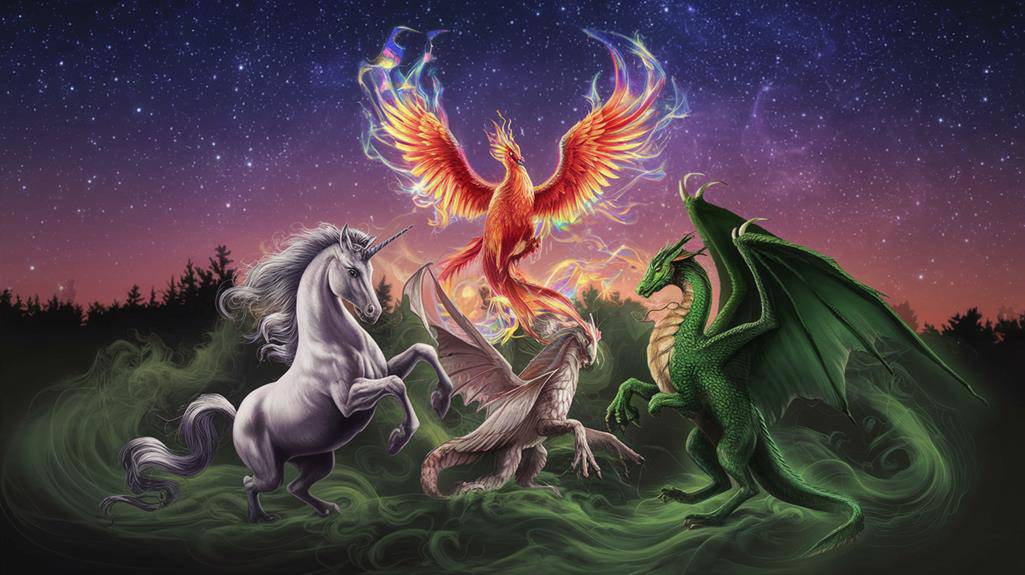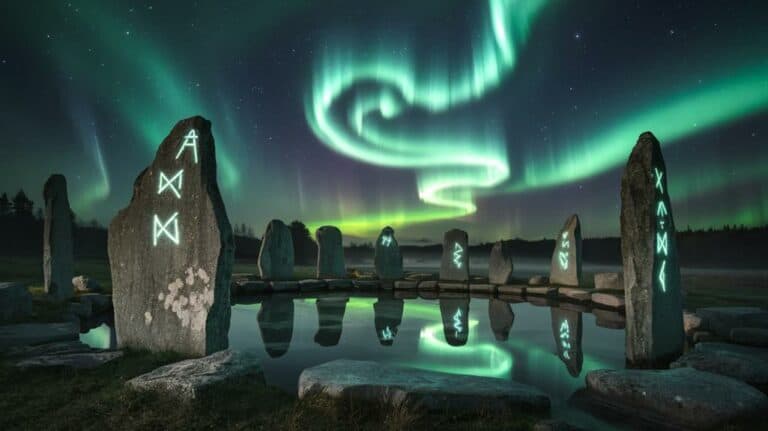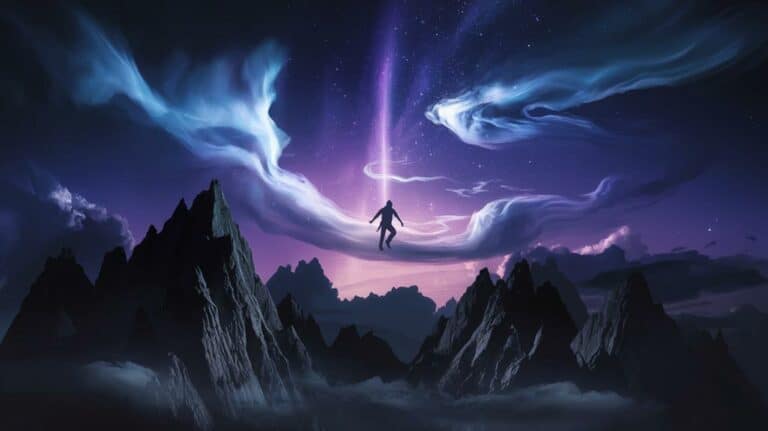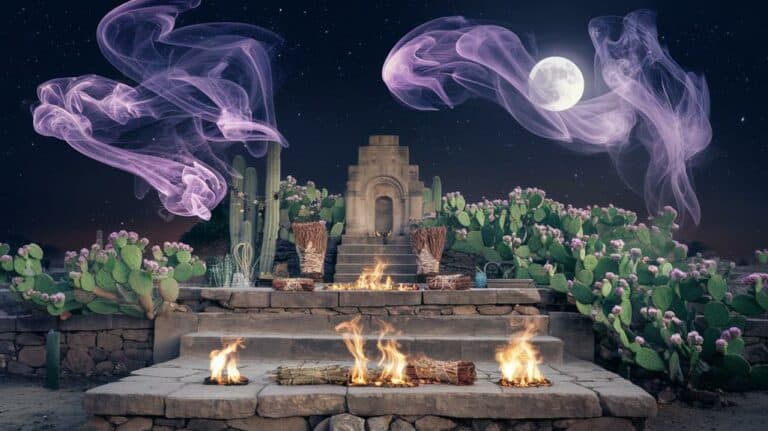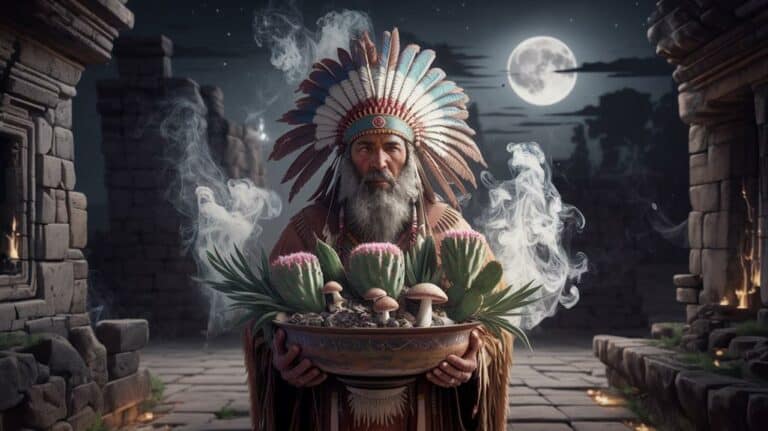15 Mystical Creatures and Their Symbolism
You’ve likely encountered mystical creatures in stories, art, and ancient texts, but their profound cultural significance extends far beyond mere entertainment. These legendary beings have shaped civilizations, influenced religious beliefs, and continue to mirror humanity’s deepest hopes and fears. From the eternal cycle of death and rebirth embodied by the Phoenix to the divine wisdom of Eastern dragons, each creature carries layers of meaning that reflect universal human experiences. As you explore these fifteen remarkable beings, you’ll discover how their symbolism remains surprisingly relevant to modern life’s challenges and transformations.
The Phoenix
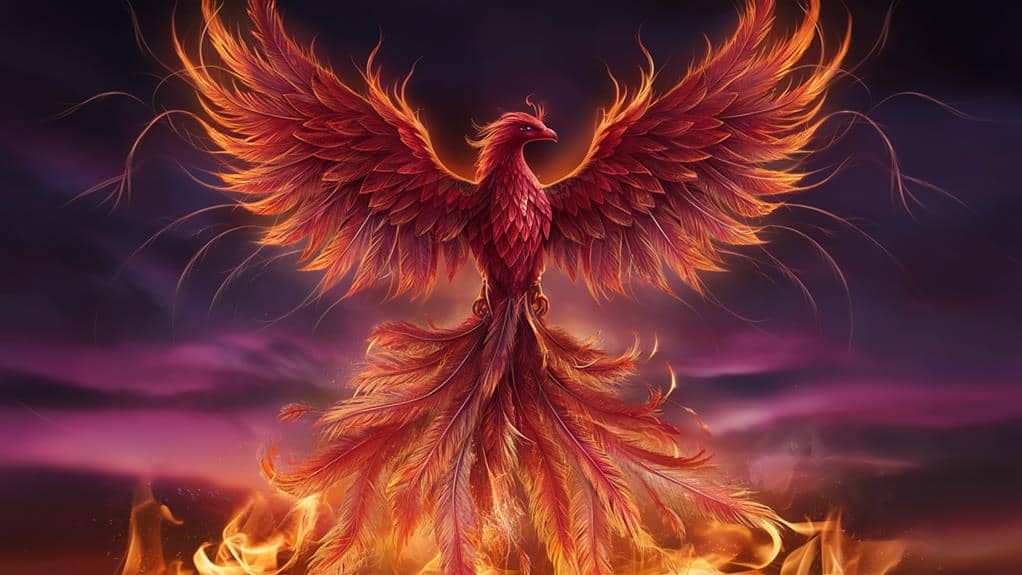
Rising from its own ashes, the Phoenix stands as one of mythology’s most enduring symbols of rebirth and transformation. When you encounter this majestic creature in ancient texts and artwork, you’ll find yourself drawn to its radiant plumage of gold and crimson, a representation of the sacred fire that both ends and begins its eternal cycle of existence.
You’ll discover the Phoenix’s presence across diverse cultures, where it’s known by different names but embodies the same profound truth: that destruction isn’t the end, but rather a gateway to renewal.
In moments of personal struggle, you might find solace in the Phoenix’s journey, recognizing that your own trials can forge a stronger, more resilient version of yourself.
The Phoenix teaches you that transformation isn’t just about survival; it’s about emerging more magnificent than before. As you contemplate its cyclical nature, you’ll understand that each ending carries within it the seeds of a new beginning.
Through the Phoenix’s eternal dance of death and rebirth, you’ll learn that your greatest moments of renewal often follow your deepest challenges.
Dragons Across Cultures
Soaring through the mythologies of countless civilizations, dragons emerge as perhaps the most universally recognized mythical creatures in human history. You’ll find these magnificent beings dancing through Eastern skies as harbingers of wisdom and celestial power, while their Western counterparts often embody nature’s raw, untamed forces.
In Chinese culture, you’re looking at benevolent creatures commanding rainfall and prosperity; in European lore, you’re facing fierce guardians of ancient treasures and forbidden knowledge.
When you explore deeper into dragon symbolism, you’ll discover how they’ve shaped humanity’s understanding of power dynamics and natural order. Norse legends speak of Nidhogg gnawing at Yggdrasil’s roots, while Aztec beliefs revere Quetzalcoatl as a feathered serpent of divine wisdom.
You’re witnessing a profound reflection of human consciousness across these varied interpretations – from the Japanese dragon’s association with water and life-giving forces to the Welsh dragon’s fierce protection of national identity.
These creatures transcend mere mythological constructs; they’re mirrors reflecting humanity’s deepest fears, highest aspirations, and eternal quest for understanding our place within the cosmos.
Sacred Unicorns
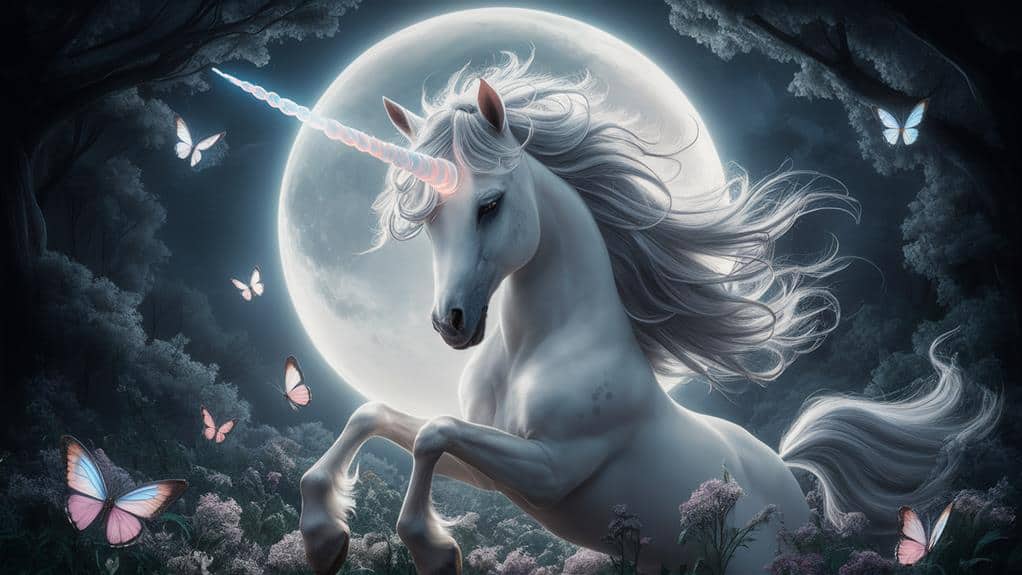
While dragons command the skies with raw power, unicorns gallop through history as symbols of purity and grace. You’ll find these ethereal beings woven into tapestries of medieval courts and whispered about in ancient forests, where they’ve captured humanity’s longing for innocence and spiritual transcendence.
Their spiral horns, believed to neutralize poison and heal the wounded, represent nature’s sacred geometry and life’s inherent ability to restore itself.
Throughout the ages, you’ve inherited stories of these majestic creatures appearing only to those deemed worthy – particularly to virgin maidens who embodied the qualities of gentleness and virtue.
In Celtic mythology, you’ll discover unicorns as guardians of the untamed wilderness, protecting sacred spaces where the veil between worlds grows thin. Their pristine white coats and luminous presence have become powerful metaphors for the divine feminine and the quest for spiritual enlightenment.
When you encounter unicorn symbolism in contemporary culture, you’re connecting to an ageless archetype that reminds you of humanity’s yearning for purity in an increasingly complex world, serving as a bridge between earthly existence and celestial aspirations.
The Mighty Griffin
The majestic griffin stands as nature’s perfect fusion of eagle and lion, combining the king of birds with the king of beasts. When you first encounter this legendary creature in ancient texts or medieval heraldry, you’ll discover its dual nature represents the harmonious balance of earthly strength and heavenly wisdom.
You’ll find that its eagle’s head and wings grant it dominion over the skies, while its lion’s body anchors it to terrestrial power.
As you explore deeper into griffin symbolism, you’ll recognize how this creature has transcended mere mythological status to become a guardian of sacred treasures and divine knowledge.
You’ll notice its presence throughout history as a symbol of nobility, wisdom, and divine protection. In your exploration of various cultures, you’ll find the griffin watching over temples, adorning royal crests, and standing sentinel at crossing points between mortal and immortal domains.
Through its vigilant eyes, you’re reminded of humanity’s eternal quest to bridge earth and sky, physical and spiritual. The griffin’s enduring presence in our collective consciousness speaks to your own innate desire to unite opposing forces within yourself.
Mermaids and Sirens
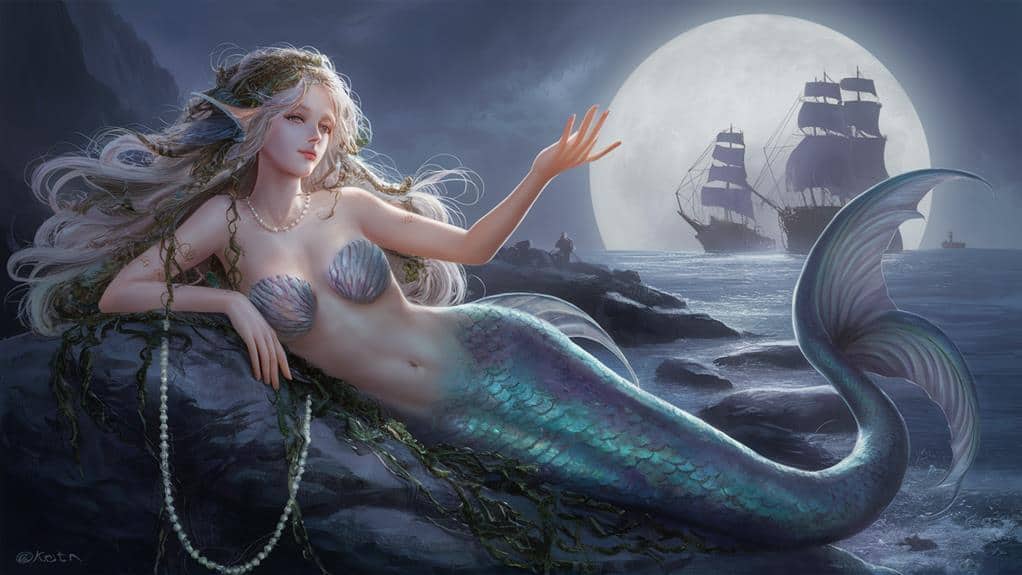
From the mythical territory of sky and land, we swim into the mysterious depths where mermaids and sirens captivate sailors and storytellers alike.
You’ll find these enigmatic beings dwelling at the intersection of human desire and oceanic mystery, their very existence challenging your understanding of nature’s boundaries. In their haunting songs and alluring presence, you’ll discover ancient warnings about the price of unchecked longing and the seductive power of the unknown.
As you explore deeper into their lore, you’ll recognize how mermaids embody humanity’s complex relationship with the sea – beautiful yet dangerous, inviting yet alien.
Their dual nature mirrors your own internal divisions: the eternal struggle between rational thought and primal desire. Sirens, their more dangerous cousins, represent the ultimate test of will, forcing you to confront your deepest vulnerabilities.
Through countless tales across cultures, they’ve emerged as powerful symbols of transformation and transcendence, reminding you that between the surface world you know and the depths you fear lies a domain of profound possibility and peril.
The Kraken
Deep beneath treacherous Nordic waters lurks one of humanity’s most fearsome oceanic nightmares – the Kraken. You’ll find this legendary beast embedded in maritime folklore, where tales speak of tentacles as thick as ship masts and eyes that pierce the darkest depths.
It’s a creature that embodies the raw, untamed power of the sea itself, challenging your perception of what lies in the unexplored abyss.
When you consider the Kraken’s symbolic significance, you’re confronting humanity’s age-old struggle with the unknown. This colossal cephalopod represents nature’s insurmountable might, reminding you that despite technological advances, you’re still at the mercy of forces far greater than yourself.
In Norse mythology, the Kraken’s emergence signals impending doom, yet it also symbolizes the hidden treasures and knowledge lying in life’s deepest waters.
You’ll recognize the Kraken’s influence in countless cultural narratives, where it serves as a metaphor for life’s overwhelming challenges.
It’s a reminder that beneath the surface of your everyday existence, primal forces continue to shape your reality, demanding respect and humility in the face of nature’s mysteries.
Centaurs of Ancient Greece
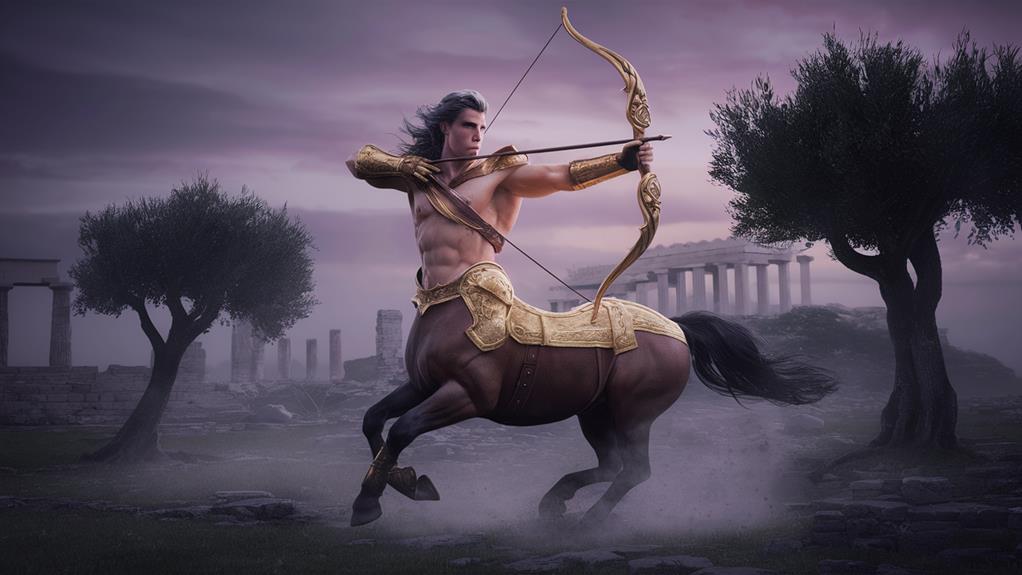
Among ancient Greek mythology’s most intriguing hybrids, centaurs gallop across your imagination with their distinctive half-human, half-horse forms.
You’ll find these powerful beings dwelling in the untamed wilderness, embodying the eternal struggle between your civilized nature and primal instincts.
As you explore deeper into their symbolism, you’ll discover that centaurs represent more than mere mythological curiosities.
They’re living metaphors for the duality that exists within you – the rational mind wrestling with passionate desires, wisdom battling against base impulses.
You’ll recognize Chiron, the wisest of centaurs, who transcended his wild nature to become a renowned teacher of heroes, showing you that transformation is possible even when opposing forces reside within.
When you contemplate the centaur’s legacy in Greek mythology, you’re confronting timeless questions about your own nature.
They’ll remind you that you’re neither purely intellectual nor entirely instinctual, but rather a complex fusion of both.
Through their stories, you’ll understand that true wisdom lies not in denying either aspect of yourself, but in achieving harmony between your competing natures.
Chinese Qilin
While ancient Greece celebrated the centaur’s duality, Chinese mythology reveres the Qilin as a symbol of benevolence and purity. You’ll find this majestic creature depicted with the body of a deer, the tail of an ox, the scales of a dragon, and a single horn adorning its noble head. When you encounter the Qilin in classical texts, you’re witnessing a being that’s said to appear only during times of virtuous leadership and profound peace.
You might wonder why the Qilin’s presence carries such weight in Chinese culture. It’s because this mythical being embodies the harmonious balance between power and gentleness – so mindful of all living things that it won’t even crush a blade of grass beneath its hooves.
When you’re studying Chinese art, you’ll notice the Qilin often appears alongside other celestial creatures like the dragon and phoenix, yet it stands apart in its role as a harbinger of sage rulers and prosperous times. The Qilin’s very existence in mythology serves as a reminder that true power lies not in dominance, but in the wisdom to lead with compassion and righteousness.
The Norse Valkyries
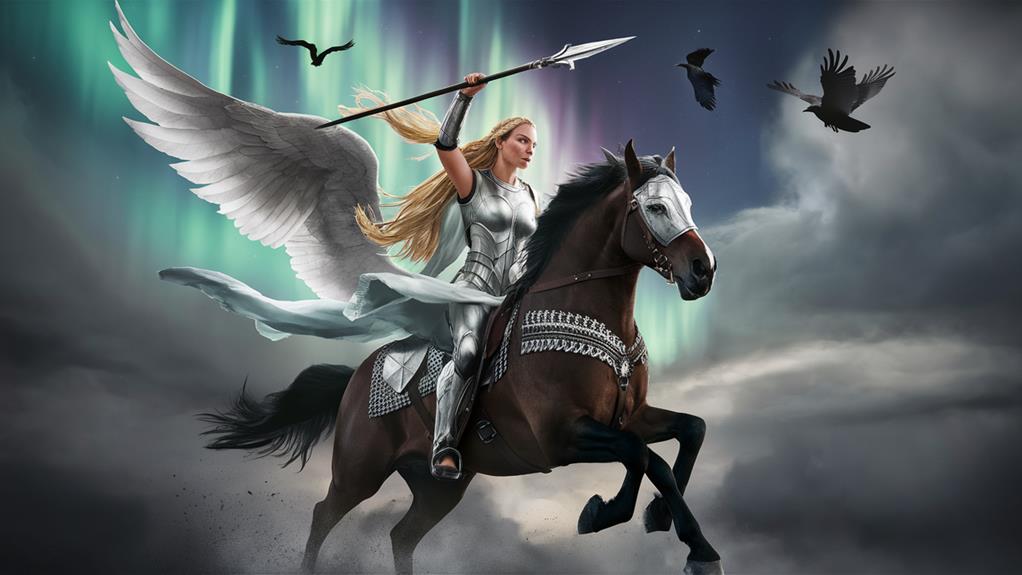
The fierce Valkyries of Norse mythology embody both beauty and brutality as they soar across battlefields choosing worthy warriors for Valhalla. You’ll find these divine maidens adorned in gleaming armor, their wings cutting through mist and smoke as they determine the fates of those who’ve fallen in combat.
They’re Odin’s chosen messengers, bridging the mortal domain with the eternal halls where brave souls feast.
When you contemplate the Valkyries’ deeper symbolism, you’ll discover they represent the delicate balance between life and death, glory and sacrifice. Their presence on the battlefield speaks to humanity’s eternal quest for meaning in mortality – they’re the ones who transform brutal death into sacred passage, common soldiers into legendary heroes.
You’ll notice that unlike other mythical beings who simply destroy or create, the Valkyries serve as cosmic arbiters, weighing the worth of each warrior’s final moments. They remind you that death isn’t always an ending, but sometimes a transcendent beginning.
In their role as choosers of the slain, they represent the ultimate freedom – the power to rise beyond mortal constraints and achieve immortality through valor.
Celtic Selkies
Shifting from the skies to the seas, mystical seal-folk known as Selkies inhabit the cold waters around Scotland and Ireland.
You’ll find these shapeshifters dwelling in the liminal spaces between land and ocean, shedding their sealskins to walk as humans upon the shore. In their human form, they’re known for their dark hair, deep eyes, and an otherworldly beauty that’s captured the hearts of countless mortals.
You might wonder about the profound symbolism these creatures embody – the eternal tension between freedom and constraint, between the wild and the domestic.
When you hear tales of Selkies whose sealskins are stolen, forcing them to remain in human form, you’re confronting ancient questions about the nature of choice and captivity. Their stories speak to your own yearnings for liberation, for the ability to move between worlds at will.
In Celtic tradition, you’ll discover that Selkies represent the transformative power of the sea itself – mercurial, mysterious, and ultimately untameable.
They remind you that true nature can’t be confined, that the call of the wild always echoes in those who hear it.
The Egyptian Sphinx
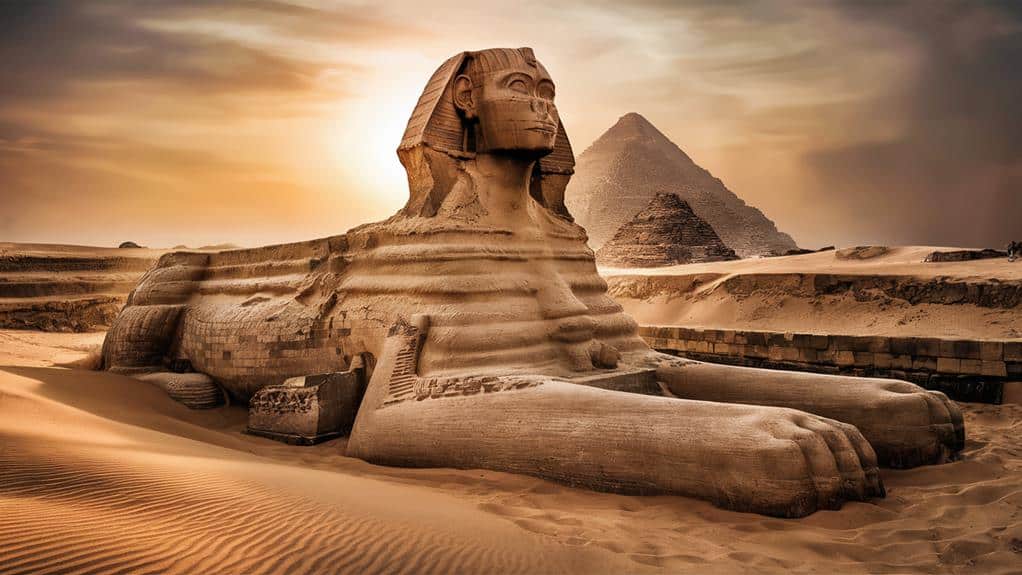
Rising from desert sands like a perpetual guardian, Egypt’s Great Sphinx stands as one of humanity’s most enduring mythological figures. You’ll find this remarkable creature, with its human head and lion’s body, embodying the perfect fusion of intellectual wisdom and raw power that’s fascinated seekers for millennia.
As you contemplate the Sphinx’s weathered features, you’ll discover it’s more than just an ancient monument – it’s a profound symbol of transformation and spiritual awakening. Its riddles, famously challenging travelers in Greek mythology, remind you that wisdom often comes at the price of deep self-reflection.
In Egyptian tradition, the Sphinx serves as the bridge between the earthly and divine domains, inviting you to transcend your ordinary consciousness. You’ll notice how the Sphinx’s eternal gaze, fixed toward the rising sun, mirrors humanity’s perpetual quest for enlightenment.
It’s a reflection of our ancestors’ understanding that true power lies not in physical might alone, but in the harmonious balance of human intellect and primal strength. When you stand before the Sphinx, you’re connecting with an ageless tradition of seeking higher truths through the marriage of opposing forces.
Japanese Kitsune
Legends tell of mystical foxes known as Kitsune, shape-shifting tricksters who’ve captivated Japanese folklore for centuries. You’ll find these enigmatic creatures gaining wisdom and power as they age, with each passing century marked by the growth of an additional tail until they reach their ninth, most sacred form.
In their pursuit of knowledge, they’ll often appear as beautiful women, seeking to understand the depths of human nature while testing the boundaries between illusion and reality.
As you explore deeper into Kitsune lore, you’ll discover their profound connection to Inari, the Shinto deity of fertility and rice, serving as divine messengers between the mortal and spiritual domains.
These celestial foxes embody the delicate balance between benevolence and mischief, wisdom and cunning, offering a mirror to your own dualistic nature. You’ll notice their presence in ancient shrines, where stone fox statues stand guard, their knowing eyes reflecting centuries of accumulated wisdom.
The Kitsune’s transformative journey from mortal fox to divine being speaks to your own potential for spiritual growth and transcendence.
The Thunderbird
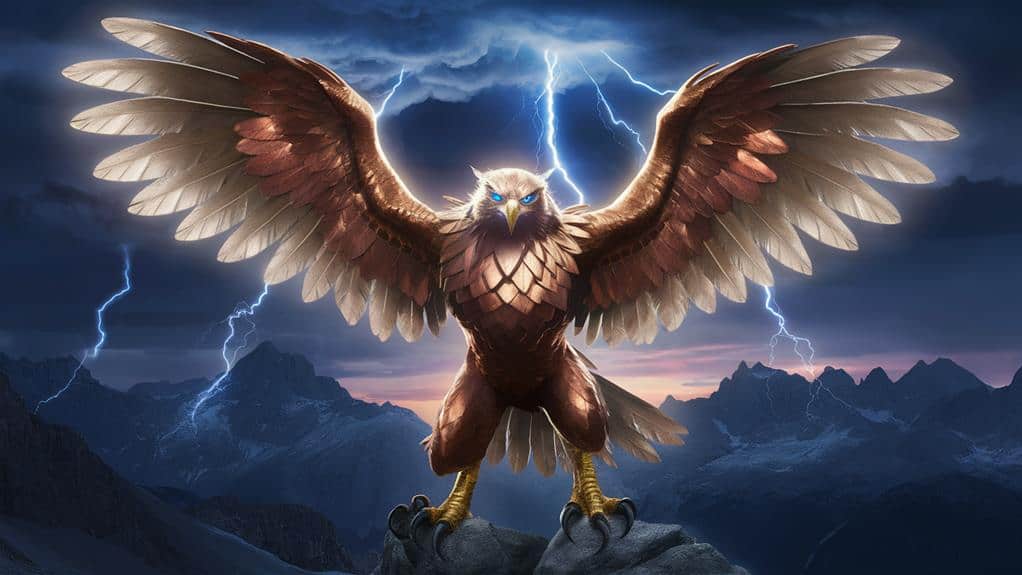
While Japanese folklore celebrates the cunning fox spirits, Native American traditions tell of a far more imposing figure – the Thunderbird. You’ll find this majestic being soaring through sacred stories, its wings spanning the width of ancient redwoods as it commands the storms and lightning that shape our world.
When you seek to understand the Thunderbird’s essence, you’ll discover it’s not merely a creature of raw power, but a spiritual guardian representing the delicate balance between earth and sky. Its thunderous wingbeats echo through time, reminding you of humanity’s connection to natural forces that exist beyond your control.
As you explore deeper into various tribal traditions, you’ll encounter tales of how the Thunderbird’s lightning-filled eyes pierce through darkness, bringing both destruction and renewal to the lands below.
In many tribes’ sacred ceremonies, you’ll witness the Thunderbird’s influence in traditional dances and rituals, where its spirit continues to bridge the mortal and divine domains.
It’s a proof of how deeply this magnificent being has woven itself into the fabric of Native American spirituality, embodying the untamed forces that shape our understanding of the natural world.
Medieval Gargoyles
From hundreds of cathedral spires across Europe, medieval gargoyles peer down at passersby with their grotesque faces and twisted forms. You’ll find these stone sentinels perched high above the ground, their weathered expressions frozen in eternal vigilance.
While they serve as waterspouts to divert rainwater from the building’s foundation, their spiritual significance runs far deeper than mere architectural function.
When you gaze upon these creatures, you’re witnessing mankind’s complex relationship with the divine and the demonic. They’re believed to ward off evil spirits, serving as protective guardians that absorb negative energy before it can enter sacred spaces.
You’ll notice how their exaggerated features – protruding eyes, sharp fangs, and contorted bodies – embody medieval society’s fears and fascinations with the supernatural domain.
In their dual nature as both protectors and monsters, they represent humanity’s eternal struggle between light and darkness.
You’re looking at more than stone sculptures; you’re seeing physical manifestations of medieval spiritual beliefs, where the boundaries between the sacred and the profane blur into haunting expressions of faith and fear.
The Legendary Pegasus
Unlike the fearsome gargoyles of medieval Europe, the majestic Pegasus soars through ancient mythology as a symbol of divine inspiration and poetic grace.
You’ll find this magnificent winged stallion galloping through the heavens, bridging the mortal domain with the divine, carrying the dreams of humanity on its powerful wings.
When you explore Greek mythology, you’ll discover how Pegasus sprang from Medusa’s severed neck, transforming horror into transcendent beauty.
You’re witnessing a creature that’s become immortalized as the faithful companion of heroes and the muse of artists across millennia.
Each beat of its wings represents your own potential to rise above earthly constraints.
In today’s world, you’ll recognize Pegasus as an enduring emblem of creative freedom and spiritual elevation.
It’s a reminder that you’re capable of transcending life’s obstacles, just as this celestial horse breaks free from gravity’s chains.
When you encounter Pegasus in art or literature, you’re connecting with an ancient power that speaks to humanity’s eternal desire to reach beyond our limitations, to touch the divine, and to transform our earthly existence into something extraordinary.



